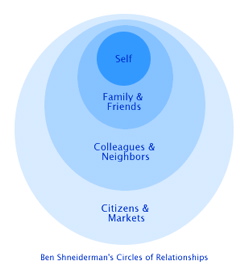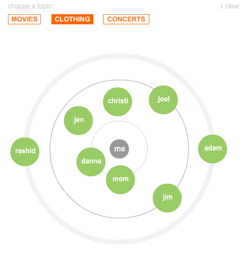Jun 18
Intranet Governance Guide
Maish Nichani has published a guide to good governance for intranets. Highlights include:
Get active management support
Develop a clear simple charter
Build an intranet team
Develop your authors
Market the intranet
Gather and use feedback (includes monitoring activity)
Conduct regular reviews.
Governance is something often missed out on in intranet projects, as in KM system projects. Too often teams assume the job is finished once the box is plugged in, software installed and the user training completed. Maish’s guide reminds us that a good intranet is (or should be) a living environment that attracts activity and traffic. That’s not going to happen by itself unless you are very very lucky. Don’t bank on being lucky – make your own luck, do the groundwork, be clear about how you want your intranet to perform for you, resource it properly and watch and cultivate it carefully.
Jun 15
Using Blogs in the Enterprise
Jack Vinson has blogged a summary of his KM class’ conclusions on how blogs could be productively used inside the enterprise (it’s a graduate programme, and his students have been blogging themselves for the whole semester). It’s great KM. Here are some of the useful things I picked up:
Jun 15
KM is Shallow, Insular and “History”

Grant Campbell over at Boxes and Arrows has written what has to be my current top contender for Blog Post of the Year. He’s writing about three common flame-war starters in the information architecture (IA) community, the accusation that information architects are shallow dilettantes, exclusive, and already passe. But his reflections can just as easily be applied to KM. Here are three hard-hitting snips (just replace his “IAs” with “knowledge managers” and see how it feels:
Jun 12
The Flu Bug Made Me Blog This
I have just returned from a 1-week army reserve training stint. Like the last time, I came home with the flu bug, and several questions about how the army could better manage its knowledge.
Jun 07
Things I’d Like to Blog About…
One of the wonders (and frustrations) of being in the blogosphere is that you come across all sorts of things that you enjoy, make you think, and that you’d like to share… but time often ensures that you can’t do them justice, so they get lost in your treasure chest of still-born blogs and things you really have to get round to reading in depth when you can. Here are a few of the recent ones likely to fall to that fate, starting with this delightfully funny map of the electromagnetic spectrum from Randall Munroe.

Jun 02
Social Networks and Identity Mapping
 It’s a temptation to think when we do social network analysis and generate a seemingly telling network visualisation that we have uncovered a significant truth about a network.
It’s a temptation to think when we do social network analysis and generate a seemingly telling network visualisation that we have uncovered a significant truth about a network.
We’ve had some really good reminders this week about how fragmentary and provisional such visualisations are. It all started with Josh Porter who has been blogging (here and here) on how we form networks that look like concentric circles, where trust dissipates outwards, using Ben Shneiderman’s “Circles of Relationships” visualisation. He got a lot of push back from folks who felt that this visualisation was too static and wasn’t adequate to the true complexity of human relationships.
Then Sarah Cooper published a small flash module that summed up the issue… well, in a flash. Go visit the live module and play with it – but essentially it demonstrates that the same people in your network can command different levels of closeness and trust depending on the topic. Click on a different topic, and the relative trust positions of the players all change.
 This is related to Karen Stephenson’s insight some years ago that we manage different identity networks in parallel, where the same people can have different degrees of closeness to us, depending on whether we are seeking career advice, want to get new perspectives and ideas, or transactional work-related information.
This is related to Karen Stephenson’s insight some years ago that we manage different identity networks in parallel, where the same people can have different degrees of closeness to us, depending on whether we are seeking career advice, want to get new perspectives and ideas, or transactional work-related information.
The lesson? We can’t ever forget that the network visualisations we generate only ever tell us the (current) answer to the single question we asked. They don’t warrant universal statements about the quality and extent of all relationships in the social group. So we need to be clear about which identities we are interested in mapping, and make sure we have mechanisms or questions designed to illuminate each of them. And even when we’ve covered the variant identities, we still need to remember that new contexts can change the relationships. Trust in social networks is like the sea: it ebbs and flows, and is constantly changing.
Jun 01
Purposeful Metadata
I’ve blogged over at www.organisingknowledge.com (my book-blog) on the need for a sense of purpose when we design metadata. Here’s how the blog post starts:
When we do taxonomy projects we almost always come to a point where we are having a conversation with our clients about metadata. In fact, we prefer to absorb metadata design into a taxonomy project, simply because it gives us so much more influence over the performance of our taxonomy – metadata design heavily influences the degree to which any given system can exploit a taxonomy in practical ways.
Often, however, the metadata design is already embedded in the technical systems part of a project, and we come to the metadata table late in the day. I find myself over-frequently meeting the “just in case” school of metadata design – often from within the IT systems design school, where more functionality is better, and more metadata means more future capabilities. “If we have the metadata, we can manipulate the content in xyz ways.”. More is better. More metadata insures you against future regret (“Oh my god, I wish we had put that metadata field in back when we were designing the system” ).
May 31
Complicated
One of the things our company Straits Knowledge does, is help clients build a knowledge management strategy, help them figure out what should go into an implementation roadmap and often even help them define supporting programmes and build action plans.
Some of these clients have had experience in doing small scale experimental KM through a variety of projects and initiatives, and now they want to broaden and integrate their efforts – this often comes from the need to start reaping larger scale value from previous knowledge management efforts.
Enterprise knowledge management brings its own challenges, and many of them come from the need to understand and address an organisation’s infrastructure. I have written about this challenge at some length in an article called “Why KM is Hard To Do”.
However, when we characterize the problem as a function of infrastructure it is still very tempting to see this as a technical problem – ie that there is an approach or a method or a series of steps we can go through to solve it. I have been reminded very recently that techniques are not enough – that human moral attributes also play a critical role.
May 23
Shhhh… the IP Addresses Have Ears
 Well it had to happen. Social network analysis in organisations has long been promoted as a way of spotting opportunities for improving collaboration and knowledge flows. Network mapping software pioneer Valdis Krebs has just celebrated his twentieth birthday in the business.
Well it had to happen. Social network analysis in organisations has long been promoted as a way of spotting opportunities for improving collaboration and knowledge flows. Network mapping software pioneer Valdis Krebs has just celebrated his twentieth birthday in the business.
Now, via Bill Ives, a nasty twist on social (or organisational) network analysis that brings us to the dark side of the force.
This week a company called eTelemetry is introducing a software application that does “Enterprise Behavior Analysis” (EBA), at the Las Vegas Interop exposition. It works by mapping individual IP addresses to users, and monitors and maps communications between employees by email, instant messaging and internet (intranet?). This far, we are on familiar social network analysis territory (except for concerns you might have about privacy and how the data might be used by paranoid and ill-informed executives… but wait, I’m getting ahead of myself).
Now let it not be said that for the eTelemetry gauchos the glass is half empty. It is most definitely half full, but not of nourishing life giving stuff. If anyone has doubted Michael Moore’s declamations about a pervasive climate of fear in the United States, then look at the primary intended use for this software touted by its makers: “the technology in Metron EBA can help managers reengineer business processes or spot anomalous employee behavior that may represent a threat to the company.” To be fair, ETelemetry also touts the normal SNA benefits of such analysis – spotting opportunities for improving connectivity in human networks, or spotting dependencies on particular individuals for information flows – but what about privacy and how the data might be interpreted by paranoid and ill-informed executives?
Indeed the whole thrust of eTelemetry’s product suite is focused on security – internal security. Its Metron application is designed to track down loafers and “network miscreants” without them being aware that they are being watched. Amongst their selling points they tout productivity gains by showing the impact on slacking when managers are present or absent, and providing accurate data that will improve the effectiveness of “external organisation network analysis consultants”.
Note to self: stay far away from these folks, get a hold of their client list and decide whether I should (a) stay far far away from any of them or (b) stand outside their gates and hand out free IP spoofing software to their employees. Be warned. Knowledge managers can be evil too.
BTW, Kim has quite a different post on surveillance today.
May 23
Happy 300th Birthday Charles

Today is the 300th birthday of Carolus Linnaeus, the great-grand-daddy of taxonomists everywhere. Dave Snowden has celebrated by publishing a gracious and hugely complimentary review of my book on his blog.
Elsewhere, the rest of the world has quite rightly focused on “Taxonomicus Chas.” as I affectionately call him. The blogosphere is humming even as I write this. But there are undercurrents to the celebrations that express the tensions buried deep in his pioneering work all those years ago.
